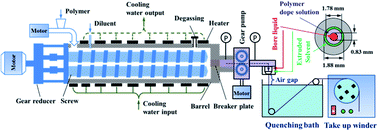Tailoring the surface pore size of hollow fiber membranes in the TIPS process†
Abstract
A new method was used to tailor the surface pore size of PVDF hollow fiber membranes in the TIPS process by the co-extrusion of different solvents at the outer layer of the extruded polymeric solution. In this method, the membrane properties can be controlled over a wide range of mean pore size (from 24 to 600 nm), water permeability (from 3 to more than 4000 L m−2 h−1 bar−1), and acceptable particle rejection (from 50 to 500 nm), with only a slight change in the membrane mechanical strength. Ternary interaction between the extruded solvent, polymer, and diluent in the polymer dope solution played a major role in controlling the hollow fiber membrane properties. At the interface of the extruded solvent and polymeric solution, segregation of the diluent or PVDF molecules near the outer skin layer of hollow fiber membrane strongly affected the mean pore size and filtration performance over a wide range, from MF membranes to typical UF membranes. Considering the competitive solubility difference between the extruded solvent and the diluent in the polymeric solution and that of PVDF, a road map has been shown for the selection of a satisfactory extruded solvent to obtain membranes with desired properties.



 Please wait while we load your content...
Please wait while we load your content...